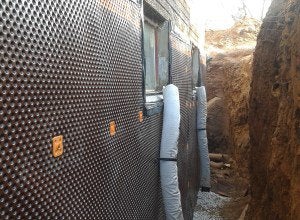What Does Newark De Basement Waterproofer Mean?
Table of ContentsThings about Newark De Basement WaterprooferNewark De Basement Waterproofer - QuestionsThe Definitive Guide for Newark De Basement WaterprooferNewark De Basement Waterproofer Can Be Fun For AnyoneThe Newark De Basement Waterproofer PDFs
Arguing while purchasing a home? Not a lot. Here's how to keep the peace while home hunting. These thick coverings are cement-like; when dry, they adhere permanently to concrete and masonry walls. newark de basement waterproofer. You apply the covering with a heavy brush made with tampico bristles a natural fiber. Swirl the brush at the final phase of application to offer the wall an appealing, ended up appearance.A 5- gallon container (you add water to the dry mix) is $30-$40 and covers 100 sq. ft. also called densifiers, are likewise appropriate only for walls that haven't been painted or sealed. The sealants take in and chemically react with ingredients in the concrete or brick, forming a difficult, water resistant surface.
Applying a silicate-based sealant with a brush, roller, or sprayer is simple enough for a Do It Yourself job. A 1-gallon can is $40-$50 and covers 200 sq. ft., but you'll require at least two coats. not all that different from ordinary wall paint. However you brush, roll, or spray it on a lot more thickly one gallon covers simply 75 square feet, not the 300 square feet common with standard paint.
About Newark De Basement Waterproofer

The entire system is $3,000-$5,000 for a 20-by-20-foot basement space. None of these products will work unless cracks and spaces are appropriately sealed. So make sure you fill fractures and gaps less than 1/8-inch large with polyurethane caulk made for masonry ($5/10-oz. tube). Spot wider fractures with epoxy filler. The surest method to waterproof your basement walls is a major exterior waterproofing option.
Exterior waterproofing includes excavating all around your home to the complete depth of the foundation walls, then installing a water resistant covering or membrane topped by drain panels. The panels supply an easy path for water to stream down to an exterior French drain at the bottom of your structure. From there, water circulations by gravity or with the aid of a sump pump far from your structure to another part of your residential or commercial property, or into a storm drain.
Some Known Facts About Newark De Basement Waterproofer.

Water in the soil causes hydrostatic pressure to be put in below basement floorings and walls. This hydrostatic pressure can force water in through cracks, which can cause significant structural damage as well as mold, decay, and other moisture-related issues. Numerous procedures exist to avoid water from penetrating a basement foundation or to divert water that has penetrated a foundation: Interior wall and flooring sealants Interior water drain Outside drain Outside waterproofing finishes Box type waterproofing [] Structure fracture injections In put concrete structures, fractures and pipeline penetrations are the most typical entry points for seepage. Although interior water drain is not technically waterproofing, it is an extensively accepted strategy in mitigating basement water and is generally described as a basement waterproofing solution. Many interior drain systems are trademarked and acknowledged by BOCA (Structure Officials and Code Administrators) as working in managing basement water.
A French drain, PVC pipeline, or a patented drain system is set up in the freshly made channel. The set up drain is covered with brand-new cement. According to Rick Jacobs of Absolute Waterproofing Solutions, a basement waterproofing and foundation repair work company, states like Michigan have a lot ground clay, which will take in and hold water, resulting in the flexing in basement foundation walls that can trigger splitting and subsequent leakages.
Things about Newark De Basement Waterproofer
FEMA advises basement waterproofing with a water alarm and "battery-operated backup pump" as a preventive procedure against the high expense of flooding. Wall channels other (such as dimple boards or other membranes) are attached to the foundation wall and cross the new drainage to guide any wetness down into the system.
It is likewise efficient if the problem has minor wetness. Generally, interior waterproofing will not stop major leaks. Waterproofing a structure from the hop over to these guys outside is the only technique the IBC (International Building Code) acknowledges as appropriate to avoid structural damage triggered by water invasion. Waterproofing an existing basement begins with excavating down sides of the footings.
The dry walls are sealed with a waterproofing membrane, and brand-new drainage tiles (weeping tiles) are put at the side of the footing. Over the previous 10 years, polymer- based waterproofing products have been established. newark de basement waterproofer. Polymer-based items last for the lifetime of the building and are not impacted by soil pH.
Newark De Basement Waterproofer Things To Know Before You Get This
Water seepage in basement and crawl areas usually occurs over extended periods of time and can be brought on Full Article by numerous aspects. Concrete is among the most frequently utilized products in house construction. When pockets of air are not removed, or the mix is not permitted to treat effectively, the concrete can split, which enables water to force its way through the wall.